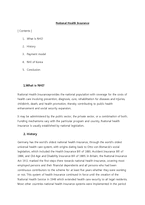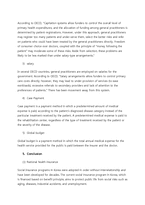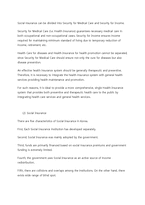국민건강보험 관리(영문)
1. What is NHI?
2. History
3. Payment model
4. NHI of Korea
5. Conclusion
Fee-for-service arrangements pay general practitioners based on the service which is decided by particular pay standards. Most of capitalistic country adopted fee-for-service and this is because the market economy is relatively well reflected. They are even more widely used for specialists working in ambulatory care.
There are two ways to set fee levels:
• By individual practitioners.
• Central negotiations (as in Japan, Germany, Canada and in France) or hybrid model (such as in Australia, France's sector 2, and New Zealand) where general practitioners can charge extra fees on top of standardized patient reimbursement rates.
2) Capitation
In capitation payment systems, general practitioners are paid for each patient on their "list", usually with adjustments for factors such as age and gender. According to OECD, "these systems are used in Italy (with some fees), in all four countries of the United Kingdom (with some fees and allowances for specific services), Austria (with fees for specific services), Denmark (one third of income with remainder fee for service), Ireland (since 1989), the Netherlands (fee-for-service for privately insured patients and public employees) and Sweden (from 1994). Capitation payments have become more frequent in “managed care” environments in the United States.”
According to OECD, "Capitation systems allow funders to control the overall level of primary health expenditures, and the allocation of funding among general practitioners is determined by patient registrations. However, under this approach, general practitioners may register too many patients and under-serve them, select the better risks and refer on patients who could have been treated by the general practitioners directly. Freedom of consumer choice over doctors, coupled with the principle of "money following the patient" may moderate some of these risks. Aside from selection, these problems are likely to be less marked than under salary-type arrangements."
3) salary
In several OECD countries, general practitioners are employed on salaries for the government. According to OECD, "Salary arrangements allow funders to control primary care costs directly; however, they may lead to under-provision of services (to ease workloads), excessive referrals to secondary providers and lack of attention to the preferences of patients." There has been movement away from this system.
4) Case Payment
2006 ,Munyoung, Association for research on Insurance Business

- 오늘 본 자료가 없습니다.
- 청소년복지론] 인터넷과 스마트폰 사용이 청소년의 삶에 미치는 이점과 문제점을 생각해보세요
- 청소년복지론] 인터넷과 스마트폰 사용이 청소년의 삶에 미치는 이점과 문제점을 생각해보세요
- 사회복지조사론토론- A 노인 요양원에서 생활하는 노인 클라이언트들의 욕구를 파악하기 위하여 조사를 진행하고 있다 면접조사가 바람직할지 또는 설문조사 바람직할지 토론하시오
- 아동발달과 연계한 아동미술의 필요성을 설명하고, 아동발달 지원을 위해 예비보육교사로서 갖추어야 할 아동미술 지도 역량을 기술하시오
- 사회복지정책의 순기능과 역기능을 각각 설명하고, 현재 시행중인 사회복지(정책)제도를 선택하여 예상되는 순기능과 역기능을 설명해주세요
해당 정보 및 게시물의 저작권과 기타 법적 책임은 자료 등록자에게 있습니다. 위 정보 및 게시물 내용의 불법적 이용,무단 전재·배포는 금지되어 있습니다. 저작권침해, 명예훼손 등 분쟁요소 발견 시 고객센터에 신고해 주시기 바랍니다.








 분야
분야

